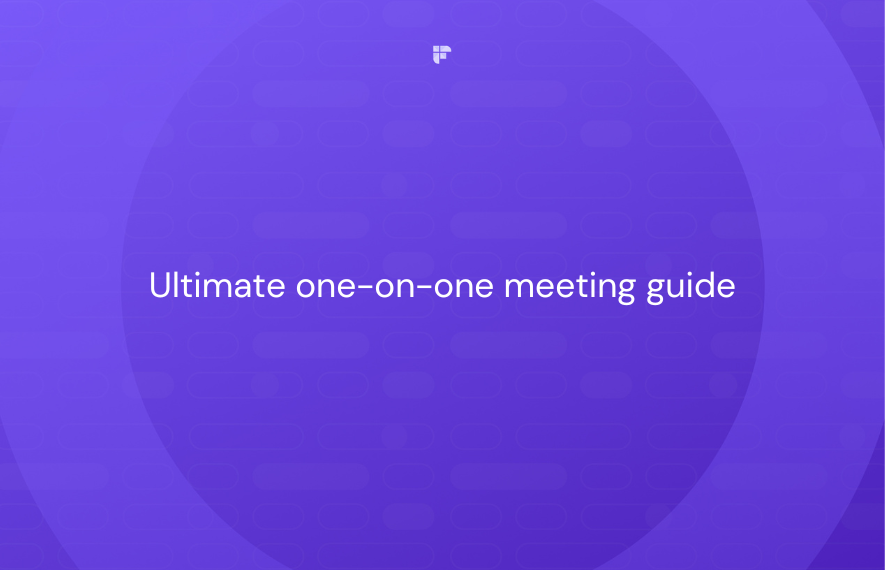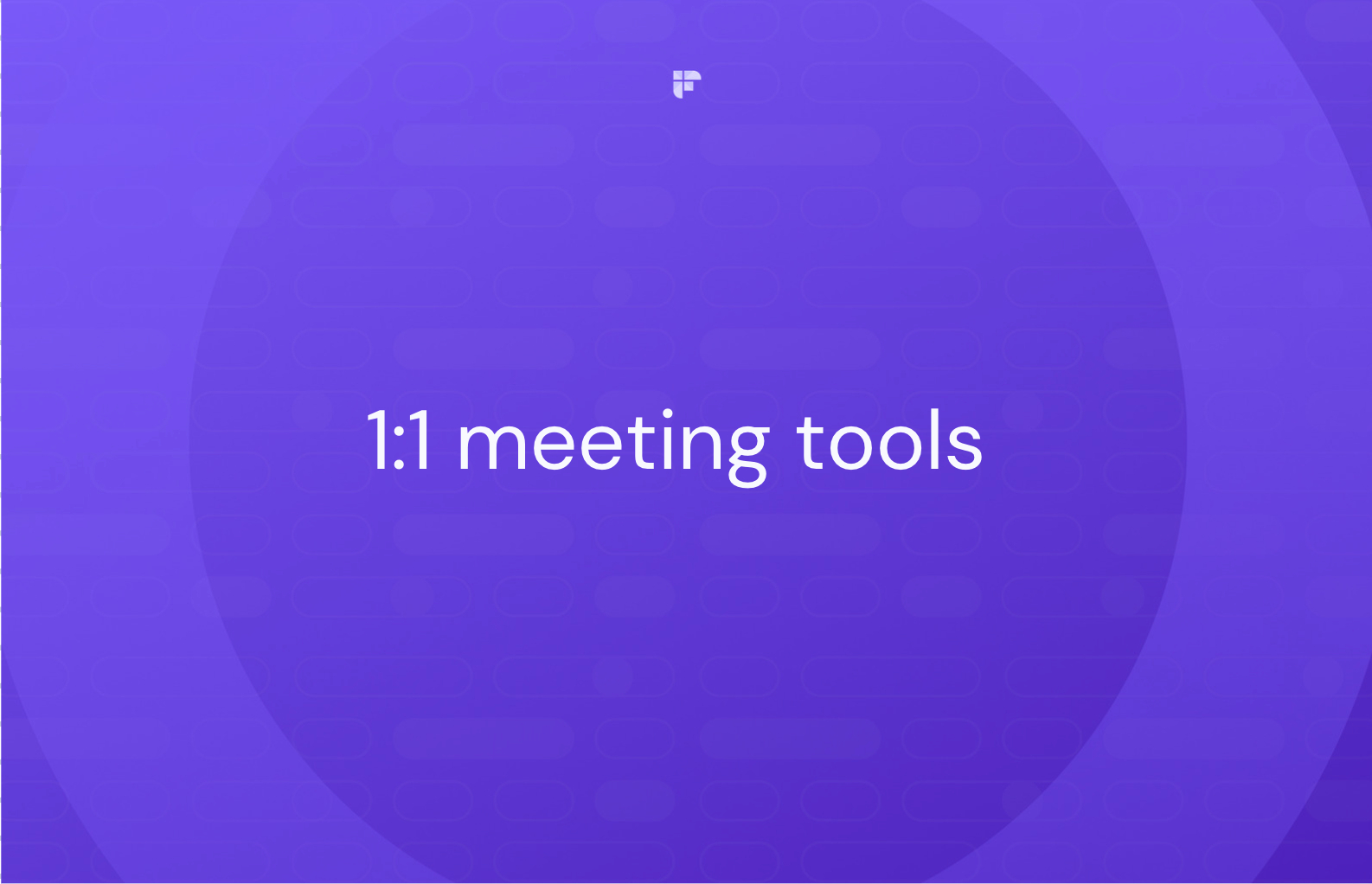In the world of Business, one-on-one meetings are the oil that aid in the smooth functioning of the corporate machinery. Managers must learn to change oils before the machine gets rusty.
Having a meeting in the business industry is the most natural part of one’s daily routine. Sometimes, you are called in for a meeting in the early hours of the day to settle an issue that was non-existent yesterday but warrants your undivided attention today.
Other times, you are on the other end of the table, giving an interview that will land you your dream job.
Whatever the case, attending meetings in the corporate world is as standard as starting your day with a hot cup of coffee. There are a plethora of meetings that happen on any given day in a busy workspace.
The meeting's objective may vary, but the end result remains the same - to come out more informed and with a better handle on affairs than you had to go in.
Several different meetings happen. You can broadly categorize them in three ways – meetings with known members of the team, meetings that are scheduled based on company need, and lastly, meetings that are called to share collective information.
Committee meetings, check-ins, one-on-ones, and board meetings fall under the first category. Brainstorming sessions, workshops, action planning, and problem-solving are some of the critical aspects of the second category.
The last type—sharing of information meetings—is based on issue resolution objectives, training sessions, and community meet-ups.

What kind of meeting is called often depends on the end goal, whether it is a regular update regarding an ongoing project or an intersection called to discuss a pressing issue.
Now you may wonder why, out of all these types, are one-on-one meetings considered so important.
The answer is quite simple; it is the easiest way to show your employees that they matter and are cared for. Let's delve further into this by understanding the significance of such a 1:1 session.
Why Are One-on-one Meetings Important?
"To win in the marketplace, you must win in the workplace."
- Dough Conant, President, and CEO of Campbell Soup Company (2001-2011)
With changing times, the dynamics between managers and employees has undergone a consistent but definite change. Today's youth grew up in the age of the internet; therefore, they are the savviest of all generations.
85% of Baby Boomers, 71% of Gen X, 46% of Gen Z, and 62% of Millennials feel that in-person meetings is the mode of communication that makes them the happiest. Given the pandemic and social distancing the next best thing is conducting one-on-one meetings.
In the beehive of corporate life, these worker bees do not pledge their allegiance to just any queen bee, but to the one that understands their needs and cares for them the way they care for the company—a relationship based on mutual benefit and respect.
And what better way is there to show your keenness in getting to know your team than your very first one-on-one meeting with employees. Here are four reasons why these one-on-ones are of considerable importance-

1. First One-on-one With New Employee: Welcome Them to the Company - It is of utmost value as first impressions have always been associated with aiding in the forging of successful, long-lasting work relationships. With your initial one-on-one, you start with a clean slate to color in your expectations and intentions.
It is the perfect way to make the newcomer feel welcomed in the family. It helps build a solid foundation right from the start.
2. Employee Retention – According to Harvard Business Review (HBR), employees don't quit a job; they quit the boss or manager. In recent years, there has been a jump in the number of people swiftly changing companies in a short period.
The stickiness that was seen as unflinching loyalty to the company has turned somewhat dull in its intensity. People have changed, so have their needs.
When a company fails in understanding its employees, they migrate, looking for one that can better cater to their desires. The reason for a large number of start-ups, apart from ideation, is the wish to work in an environment that is self-regulated, thriving, and encouraging.
"When you have a manager who cares about your happiness and success, your career and your life, you end up with a better job, and it's hard to imagine working anywhere else." - HBR.

3. Happier Employees, Better Productivity – A study conducted at the University of Warwick shows that happier employees were more productive than their peers by almost 12%.
A company that values its employees appreciates their work, gives credit where it is due, and strengthens the employee-employer relationship leading to better performance and a dedicated workforce.
4. Rapport Building – One-on-ones are perfect to talk out any issues, work-related or otherwise, that may be on your employees' minds. It is an excellent way to stay in tune with their emotions and thought processes.
It helps build trust and rapport. An additional benefit is that you avoid being blindsided and can eliminate unwanted surprises that may come your way.
The concept of work-life balance is not as new as it seems, but it is only in recent years that companies have started taking it seriously. Hence the birth of "start-up culture" with its casual dressing, flexible working hours, and Friday evening drinks.
Unlike the professionals of the yore, young professionals today treasure their life outside of work. The "work is life" adage has changed to "work is a part of your life," which is a rather smart and refreshing way to evaluate living.
This "work hard, play hard" attitude is crucial to maintain this delicate balance. The problem arises when one end of the seesaw dips.
This dip is bound to affect the employee, and this is when the one-on-one sessions come into play, trying to understand the reason for the dip on either side.
The benefits of one-on-one meetings are numerous. It is an "emotional savings account" one that you can withdraw from during tough times. The key is to make sure that the account never runs dry.
Your strategy should be to look approachable and relatable, caring, understanding, and provide individualized attention.
The next thing that might concern you is how do you handle one-on-one meetings with employees? What do people typically talk about in their 1-1s? How to conduct initial one-on-one? How often do you hold 1:1 meetings with your employees?
All very reasonable and justified concerns. Don't worry. We got you covered.
What to Discuss in the Initial One-on-one Meeting With Employees

A large part of your communication is non-verbal. Covid might have changed our communication medium from direct to electronic. Still, with technologies evolving according to the need, the fundamental aspects of communication remain the same.
You might not sit facing your team around a table in the conference room, but with applications like Zoom and Skype, your team is just a call away. It is essential to maintain the decorum of a meeting. Some general psychological markers to keep in mind when conducting one-on-ones are -
1. Sit straight but not stiff. Relax your back and avoid crossing your arms.
2. Make sure to maintain eye contact.
3. Nod along when the employee is talking about an issue. It shows that you are attentive and encourages them to speak more candidly.
4. Welcome them into the meeting with a smile and fresh energy. Your opening remarks and attitude will set the mood for the session. Therefore, make sure it is positive and motivating!
These simple but effective techniques will help you ace that non-verbal game with ease. Now let's gear up for the verbal part.
Initial one-on-one can be especially nerve-wracking. As you know, your interaction with every employee is unique in nature. Therefore, your questions must acknowledge that uniqueness and should be framed accordingly.

That being said, you can use some basic questions as a blueprint to start from and then build on as you go. Here are a set of questions that you can refer to get that meeting going –
Personal Touch
1. How have you been dealing with things lately?
Reason – In such unprecedented times, it's essential to start a conversation by checking in about their mental health. Their response will give you a rough idea regarding their general well-being.
A healthy mind resides in a healthy body, but a troubled mind may very well fatigue a healthy body. Even if they are doing fine, mental fatigue may cause physical fatigue if left unchecked. It is pertinent to make sure that your employees are in a healthy mental place.
2. Is there anything we can do to make your personal life better?
Reason – Because you care, and you want them to know that the company supports them outside the office. In many instances, people don't really expect the company actually to do something for them. Still, it's the reassurance they seek, that somebody has their back.

3. Is there something happening in your life that you think is affecting your work/output?
Reason – The reason for asking this question is pretty straight forward. You don't want your employees being occupied with issues of home while they are at work. Such a situation will only take a toll on their minds and productivity.
So what do you do? You offer a helping hand. A chance to sit, discuss reasons for their distress, and work together on a solution.
Work-related Concerns
1. What are your goals? What are some of the obstacles you are facing in achieving those? And how can we help?
Reason – This question is multi-facet. One, it helps you assess where the employee thinks they are career-wise and where they want to be. Second, it'll help you understand the places that they feel stuck in and the challenges they are trying to overcome.
Third, and probably the most important of all, you display a willingness to proactively help them succeed in being who they want to be. That can either be done by training or helping them learn the desired skills.
2. What part of the job is satisfying and which isn't?
Reason – A lot of young professionals join jobs with certain expectations. When the job's reality takes a different turn, their enthusiasm and motivation take a hit. Therefore, it is the duty of the manager to see what can be done to align this mismatch.
3. Which project/task have you had the most fun working on?
Reason – All of us are powered with different creative energies. And it is the job of the manager to find out and point them in the right direction. Make sure Elton John of your team isn't stuck trying to play the hoops while Michael Jordan is sitting on the desk, trying to pen down songs.
This question will help you understand the strengths and fallbacks of your employees and distribute tasks accordingly.
Feedback – Yes, you need to improve too.

1. Is there something you want to know about me?
Reason – You can't expect your employees to bare their hearts to you. In a game of give and take of sincerity, you have to lead by example. If you want honesty, you have to show vulnerability too. For them to trust you, you have to show you trust them also. This question paves the quickest way to trust-building in that initial one-on-one meeting.
2. One thing you like about our management style and one thing you believe we can improve?
Reason – Helmut Schmidt famously said, "The biggest room in the world is the room for improvement." The best way you can evaluate your style’s strengths and weaknesses are by getting feedback from your peers and subordinates.
A little constructive criticism to make your employees feel more empowered and content at their jobs should be a win in your dictionary.
Useful Tips for Your First One-on-one Meetings with Employees

Armed with all this information, you are ready to go and absolutely nail your next one-on-one meeting. But before you leave with your arsenal of knowledge, here are some useful tip that would be the cherry on top that would not only be of use for your first one-on-one but other successful one-on-ones that would follow –
1. Stay Calm
No matter how prepared you are for a meeting, how well you think you know your employee, how good of a rapport you have with them, there is always a chance that a curveball comes your way. During such situations, it is best to stay calm. Remember to respond, not react.
2. Learn to Engage
As is known, a conversation is between a minimum of two people. Ensure there ARE two people conversing and not just one side asking and answering before the other person has a chance.
Do not cut them off between sentences; let them completely before moving on to the next questions.
3. Understand Your Audience
Every employee prefers a different method of communication. Some like to talk; others don't. You need to know how to create an environment where they feel comfortable enough to communicate. For example, one who isn't comfortable with face-to-face conversation can answer all your questions through email.
4. Use the Correct Tools
Technology has advanced, and so should you. Use the magic of tools to make your life easy!
There are some fantastic tools and applications—Dropbox, GoToMeeting, Slack—that make the task of conducting a virtual meeting organized and stress-free. Make your life simple and choose the best productivity apps available at your disposal.
And, why look further. Fireflies.ai that records your conversations but sends you shareable transcripts of the session within 15 mins once the conference has concluded.
You can keep track of the pointers, time-stamped, discussed during a meeting and prepare accordingly for the next.
The pricing vary with more advanced features. You can create custom topics, react, comment, and upload soundbites. Upgraded plans offer additional benefits like API access, payments by invoice, integrations with CRM, Zapier, Slack, and much more.
Also worth reading :

5. Choose Your Words Wisely
Choosing what you say is as important as choosing how you say it. Try to substitute strong words with their lesser negating siblings. For example, use the word "unsuccessful" instead of "rejection" or "failed." Saying the correct words have a strong psychological effect on how an individual perceives new information.
6. Be Attentive
Your staff needs to know that when they talk, you listen. You don't fidget with your mobile or stare absentmindedly at the ceiling while they share their troubles; you actually listen.
7. Fix a Schedule That Works for You Both
Your employees are social beings with prior commitments. Therefore, it would always be wise to ask them whether a day or time suits them before you schedule a 1:1. Provide them an alternative to choose from.
Also, please, remember never to be that manager who organizes a one-on-one at the end of a long day; when employees are already tired and just want to go home!

8. Prepare a Structure for Your Meeting
Before the meeting, you need to be clear on the type of meeting it is. Is it just a regular check-in, or you want to cover some specific topics and have an in-depth discussion?
Once you are clear about the objective, make a written plan or mental map regarding what your objectives are through this meeting. An organized agenda will help in smooth sailing.
9. Chart an Action Plan
This is more fit for second or consecutive meetings. With concerns and issues addressed during the first one-on-one, you now need to have an action plan regarding how to tackle the matters discussed.
So that your employees know that when they come to you with a question, they will leave with a solution. For example, if you haven't found the right answer by the next meeting, you can always say, "I am still working on finding the best possible solution to our problem."
10. Keep a Neutral Approach Between Friendly and Bossy
An essential factor during the one-on-one is maintaining a balance between professional and friendly. Because it is a workplace, and the success of the meeting depends on how productive it was.
You are not their therapist but not a stone-cold boss either. The meeting must have a sense of professionalism mixed with an easy-going rapport.
11. Consistency in the Scheduling of the Meetings
You have to be consistent in your scheduling. You can decide whether you prefer it monthly or weekly, and then stick to it.
12. Be Approachable and Relatable
Be the boss your employees aspire to be. Inspire them by telling how you too started with an entry-level position and things that went wrong and how you handled them. Share funny instances, anecdotes, keep the morale high.
13. Be Appreciative
Let's be honest; we are all suckers for being commended or appreciated for our hard work. Don't be a miser when it comes to being grateful for all the work your people put in!
14. Empathize With Their Problems
The most powerful emotion of all is empathy. What you may consider a trivial issue may be the reason that is keeping them up at night. You need to show that all of their problems are dealt with seriousness and sincerity.
For example, one of the team members is unable to understand how specific tools work. You need to make sure he/she is taught and trained till he/she feels confident using it.
15. Go the Extra Mile
With remote working, you may have a diverse staff of different nationalities. Learn a little about their world and culture. Never underestimate the magic of personal touch!
For example, if you have a globally spread team, welcome them by saying "hello" in their language.
23 Useful Work From Home Apps and Tools to Simplify Your Work
Managing your force and conducting one-on-ones is no easy task, and we get that, but with these tips and tricks up your sleeve, you'll be acing that manager game in no time!
Read Next:









